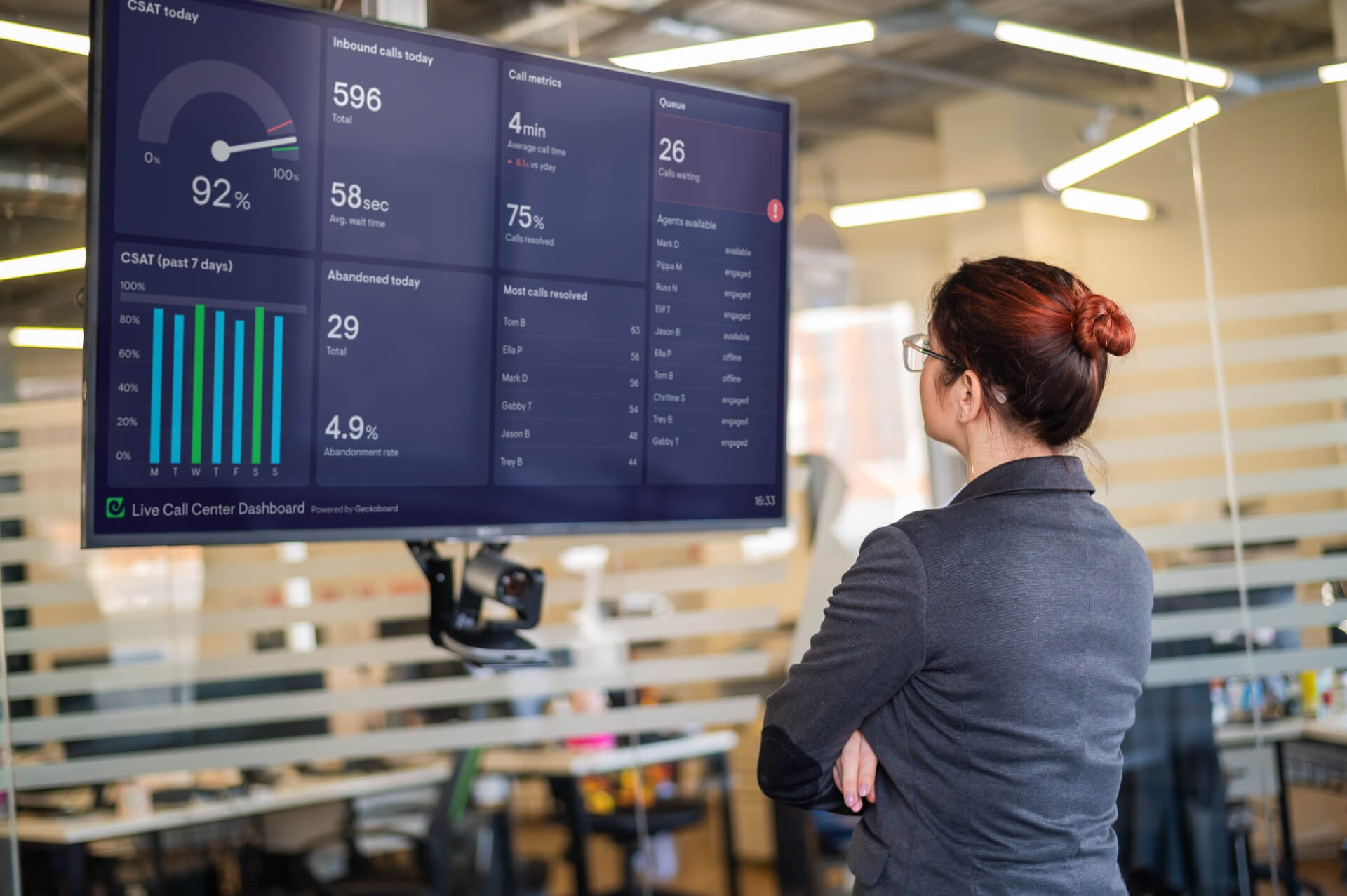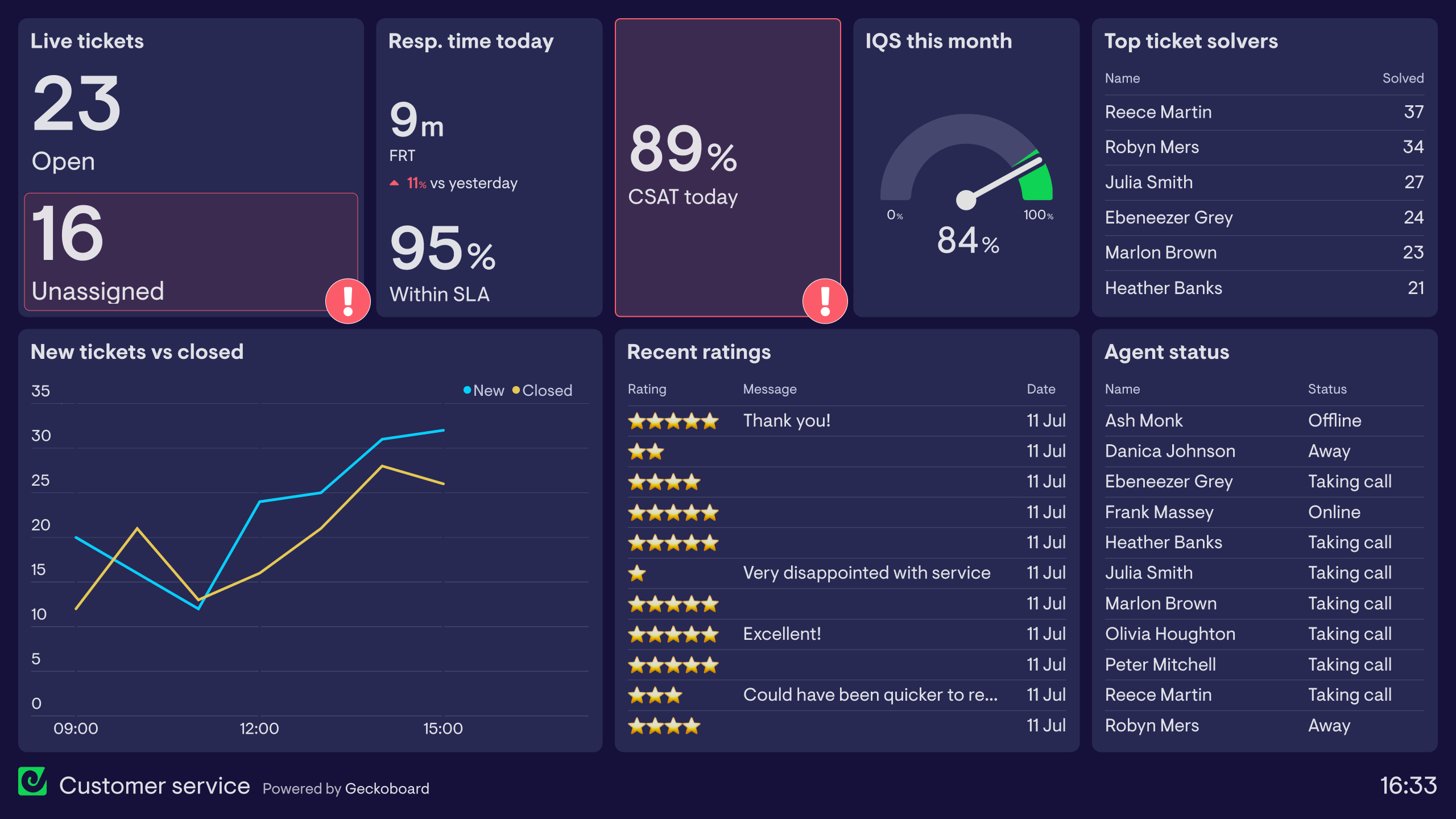Call centers are often on the front line of customer experience and CX, making them crucial business touchpoints. And with the rise of automation and AI technologies, customers expect quick responses and fast resolutions to their problems.
While these new technologies bring incredible new ways to serve and delight your customers, customers still turn to call centers and contact centers for complex issues that require human expertise to untangle. Those interactions can directly impact customer satisfaction, brand reputation, and overall business success.
They also place call centers under increasing pressure to deliver exceptional customer service while operating with maximum efficiency.
This leads to the question: How do you improve your call center’s productivity while also ensuring you’re still delivering a good customer experience (CX)?
In this article, we'll explore some KPIs you can use to measure your call center performance, along with some practical steps you can take to boost productivity – including using a live data dashboard.

Measuring call center productivity: Key Performance Indicators (KPIs)
The key to success in your call center, and by extension, your business, largely depends on the productivity of your call center agents. But how is a call center agent's productivity measured?
Measuring call center productivity starts with tracking the right KPIs. Let's take a look at some essential productivity metrics.
Average Handle Time (AHT)
AHT measures the average duration of each customer interaction—including any related after-contact work. Keeping an eye on AHT can help you identify opportunities to reduce call times without compromising service quality.
A shorter AHT can mean increased agent efficiency and happier customers. But rather than aiming for the lowest number possible, consider what makes sense for your business and the level of care you want to provide.
First Contact Resolution (FCR)
FCR measures the percentage of customer issues resolved in the first interaction. A higher FCR rate means your team excels at helping customers on the first try—without the need for multiple follow-ups.
83% of customers expect to solve complex problems by speaking to one person. Studies have shown that for every 1% increase in FCR, you can see a 1% decrease in operating costs.
Customer Satisfaction Score (CSAT)
CSAT measures customer satisfaction based on post-call surveys asking them to rate their experience from 1–5. While it’s not a direct measure of productivity, it's a valuable indicator of service quality and overall customer experience. As you ramp up your team’s productivity, be careful not to reduce your CSAT score.
A good CSAT score means you’re keeping your customers happy. Monitoring CSAT helps you identify areas for improvement and track customer sentiment.
Call Abandonment Rate
Call Abandonment Rate is the percentage of inbound calls where the customer abandons the call before speaking to an agent.
Long hold times (caused by factors such as understaffing or lack of self-service options) are the most common cause of a high Call Abandonment Rate.
A high abandonment rate will negatively impact customer satisfaction and retention. It’s an important metric to measure in order to provide excellent customer service.
Agent Occupancy Rate
This metric measures the percentage of time agents spend on active calls or handling customer-related tasks. High occupancy rates mean that your agents are spending the bulk of their time on what matters most—your customers.
For a deeper look into what Support KPIs to measure (and how to measure them), check out Geckoboard’s Customer Support KPI Guide.
How to approach call center KPIs
It’s easy to think that all you need to do is pick a few standard KPIs and then you’re off to the races. They’re common metrics, so of course they’ll work for your team, right?
Not quite.
There are two big things to keep in mind when you’re setting KPIs for your call center:
- Be thoughtful about your benchmarks. Benchmarks can be helpful because they give you a standard measuring point. If the average AHT in your industry is four minutes, then maybe that’s a good goal for your team.
But benchmarks, especially industry benchmarks, can also lead you astray, because they don’t always take into account the nuances of your business and your customers’ preferences. For instance, maybe you want to keep customers on the phone longer to facilitate a meaningful conversation or to explore ways to upsell them. If that’s the case, your AHT goal may need to be significantly above the average.
The best approach is to consider both industry benchmarks and your historical data. Use your previous performance to set realistic yet stretching goals for your call center. - Find the right metric mix. Isolating any call center metric leads to problems, because no single metric can give you the full picture of your team’s productivity and your customers’ experience. Aiming for a mixture of metrics that track different aspects of your team’s performance is a better approach.
For starters, consider choosing at least one metric to track quality and one metric to track efficiency—like CSAT and AHT.
Over time, you’ll likely find that your metrics are closely connected—if AHT drops too low, CSAT may also drop. If FCR climbs up, CSAT may also go up.
Learning from CX leaders
As you look to improve productivity in your call center team, it’s smart to peek into the playbooks of companies known for excellent CX and to emulate what works.
Let's look into some best practices for call centers.
Implement real-time KPI dashboards
Boost productivity by implementing a real-time support KPI dashboard with Geckoboard.
These dashboards visualize live data from data sources such as Zendesk, Aircall and Dixa – providing agents and team leaders instant visibility into key metrics, fostering transparency, accountability, and healthy competition. Agents can track their performance and make data-driven decisions to improve efficiency and meet targets.
And it’s not only valuable for your team. Consider making data accessible across your business to champion an open, data-driven culture.
Here are some dashboard ideas, which show some of the use cases. Including how you can design dashboards which:
- Monitor important health metrics in real time
- Visualize KPIs like FRT and CSAT
- Keep globally distributed teams focused on the same metrics
- Celebrate high performance, and encourage healthy competition

Invest in self-service options
Give your customers self-service options like FAQ pages, chatbots, and knowledge bases. These empower customers to find solutions independently, reducing call volumes and freeing up agents to handle more complex issues.
What’s more, it’s what customers expect.
The use of self-service options has continued to increase since the pandemic, with as many as 58% of customers using chatbots and 65% using self-service portals.
As you implement more self-service options, beware that more effective self-service can have a seemingly “negative” impact on some of your KPIs.
For example, say your self-service dramatically reduces the number of “easy” tickets your team receives. Since they’re focused on harder tickets, they’ll likely need to spend more time on each ticket, which can cause metrics like AHT to increase.
Establish a quality assurance program
A good quality assurance program is a fantastic way to ensure your call center team is continually improving. Things like call monitoring, conversation reviews, and shadowing are some common functions of QA teams in call centers.
Quality assurance helps identify and prevent potential problems, and it’s also a way to contribute to your team's professional development. Regular feedback and coaching sessions help agents improve their skills, enhancing productivity and customer satisfaction.
Embrace omnichannel support strategically
83% of customers say they expect to be attended to immediately when they contact a company.
By offering customer support across multiple channels—like phone, email, chat, and social media—you can meet your customers where they’re at. This can often create a better experience, while also having impacts like reducing response times and improving first contact resolution.
Plus, having diversified tasks is a great way to keep your agents feeling engaged. Call center work (or any work, for that matter) can become monotonous if you’re doing the same thing all day long. By keeping your call center agents fresh, you’ll help encourage high productivity throughout the day.
Training your team on different support methods not only keeps customers happy and agents engaged, but also ensures that you have a flexible workforce capable of handling various tasks, reducing dependency on specific individuals.
Foster a positive work environment
Creating a positive and supportive work environment is key to employee engagement and satisfaction—and engaged employees are productive employees.
Every employee’s motivations and preferences can be different, but recognizing and rewarding outstanding performance is sure to drive up your call center’s productivity.
Related strategies—like encouraging collaboration and providing growth opportunities—also have a massive impact on motivating your team to deliver exceptional customer service.
Strategies to improve call center productivity
We’ve learned a lot so far, but how can you implement any of this in your call center? Let's explore some actionable strategies to ramp up call center productivity.
Motivate your team
While extrinsic motivation, like performance-based incentives, can be effective, intrinsic motivation—the natural drive to do something simply because you find it fun or you really care about it—plays a crucial role in sustained productivity.
Some ways to foster intrinsic motivation in your team:
- Promote autonomy. Encourage your agents to take ownership of their roles and contribute ideas about their team’s processes.
- Provide opportunities for personal growth and skill development.
- Recognize and appreciate agent achievements and contributions.
- Implement employee engagement initiatives (such as team-building or wellness programs) to boost morale and job satisfaction.
Communicate effectively
Establish clear and open lines of communication within your team. Open communication inspires trust, and continuously communicating company goals and how your team contributes to them will keep your team motivated and productive.
Encourage agents to share best practices and lessons learned with their coworkers to drive continuous improvement.
Regular team meetings, huddles, and feedback sessions are great opportunities to promote collaboration, address challenges, and ensure everyone is aligned with goals and expectations.
Continuous training and development
Invest in the development of your team with ongoing training programs. Use performance metrics to identify areas of improvement and tailor training to address any problem areas.
Training on soft skills like active listening, problem-solving, and empathy improve customer interactions and boost productivity.
And, of course, don’t forget regular training on updates to your product or business to ensure your agents have the information they need to provide excellent support.
Keep knowledge management systems up to date
A robust knowledge management system will provide agents with quick access to relevant information and resources. A comprehensive knowledge base enables agents to resolve customer issues efficiently, reducing call handling time and improving overall productivity.
Start by:
- Auditing your existing knowledge base for gaps. What common questions are unanswered?
- Engaging your team in knowledge management. Knowledge-Centered Service is a proven methodology to improve your knowledge base and productivity.
Leverage the power of AI technology
And last, but certainly not least, we have to mention artificial intelligence.
Incorporating AI into your call center operations has the potential to transform productivity by automating low-value tasks, providing valuable insights, and enhancing customer interactions.
Here are some ways AI can be used to improve call center productivity:
- Predictive Call Routing
- Call Analytics
- Personalized Customer Experiences
- Interactive Voice Response (IVR)
- Conversational AI / Chatbots
- AI-Powered Recommendations
Generative AI is changing the game for many industries, including customer service. While it’s still too early to predict what the future will look like, in the months and years ahead we’ll likely see successful companies leveraging AI to dramatically increase the productivity of their human team members.
Commit to continuous improvement for higher productivity
Remember, the key to creating a highly productive call center lies in combining data-driven insights, employee engagement, effective processes, and continuous improvement.
With dedication and the right strategies, call centers can thrive in the AI era and deliver exceptional customer experiences.
If you’re looking for a quick way to get started, nothing is easier than giving your team improved visibility into your key metrics using Geckoboard. Start a 14-day free trial of Geckoboard here and create as many shareable dashboards as you’d like!
Author: Danielle Lewis
Bio: Danielle has spent most of the last decade working in customer support and product management for tech companies. She loves writing and creating content, and she writes regularly for Supported Content. You can find her on LinkedIn.

